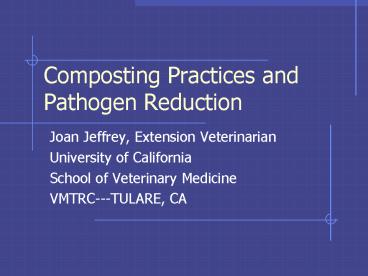Composting Practices and Pathogen Reduction - PowerPoint PPT Presentation
1 / 19
Title:
Composting Practices and Pathogen Reduction
Description:
Application of heat over time kills mesophilic bacteria and favors thermophilic ... waste = food, dairy products, raw/cooked meat, dead animals (cows, poultry, fish) ... – PowerPoint PPT presentation
Number of Views:140
Avg rating:3.0/5.0
Title: Composting Practices and Pathogen Reduction
1
Composting Practices and Pathogen Reduction
- Joan Jeffrey, Extension Veterinarian
- University of California
- School of Veterinary Medicine
- VMTRC---TULARE, CA
2
Composting
- Heat generated by microbial activity
- Application of heat over time kills mesophilic
bacteria and favors thermophilic bacterial
population - Bacteria in mature compost compete against and
inhibit pathogen regrowth
3
Composting methods
- Passive Aerated Static Piles or Windrows
- Stacked Pile
- Aerated Stacked Pile
- Windrow
- Enclosed System
- Containerized Systems (Aerated Static Piles in a
box)
4
Methods applicable to non-green waste
- Non-green waste food, dairy products,
raw/cooked meat, dead animals (cows, poultry,
fish)
5
Methods applied to poultry carcasses
- Two stage bin composting
- Refers to 2 heating cycles
- Containerized system
- Reference FS 717 U. of Maryland
6
Methods suitable for blood/feathers
- Windrow
- Most common method for green waste/manures
- gt3000 facilities in USA
- Rows 8 ft high x 12-16 feet wide
- Approved by EPA for pathogen destruction if
windrows are turned 5x in 15 d and temperatures
stay gt 131 F (55 C) - Aerated Static Pile
- Piles 7 to 9 feet high connected to blowers
- Approved by EPA for pathogen destruction
- Requires 131 F (55 C) for 3 days
7
Federal guidelines for pathogen destruction in
compost
- For windrows15 days, turned no less than 5
times, temperature of 131 F (55 C) - For aerated static piles3 days at temperature
gt131 F (55 C) - Governed by Code of Federal Regulations 40, CFR
Part 503, 1993
8
Killing of pathogens during composting
- Temperature (thermal kill)
- Ammonia (chemical kill)
- Microbial antagonism
9
Rate of microbial decomposition
- A function of surface area
- i.e. whole carcasses would compost at a slower
rate than tissues like blood or feathers
10
Temperature-Time relationships for pathogen
reduction
- D-values time required for 1 log reduction in a
pathogen at a given temperature - Can compare hardiness of different organisms
- Used to establish pathogen elimination criteria
11
Poultry pathogens addressed by specific studies
- Senne, D. A., et al. (1994) Highly Pathogenic
Avian Influenza virus and EDS-76 Adenovirus - Compost Bin method used with poultry carcasses
- Two-stage
- Turned after 10 days
- Average temperatures 57-58 C
- 1/20 tissues positive for adenovirus at d 10
- 0/20 tissues positive for virus at d 20
12
Poultry pathogens addressed by specific studies
- Conner, D. E. et al. (1991)
- Fungi and coliform, aerobic, anaerobic,
thermophilic and thermotolerant bacteria were
represented - S. enteritidis, S. typhimurium, S. seftenberg,
- L. monocytogenes, E. coli, P. multocida and
Aspergillus fumigatus - Used wheat straw, peanut hulls and other
materials - Pathogens placed into carcasses
- No bacteria after stage I of composting
- No fungal spores after stage II of composting
13
Poultry pathogens addressed by specific studies
- Murphy, D. W. et al. (1990)
- Newcastle disease virus
- Infectious Bursal Disease virus
- Bin compost method for carcasses
- Two stage composting method
14
Other pathogens addressed by specific studies
- M. tuberculosis (Morgan McDonald 69)
- Salmonella, Shigella, poliovirus, enterovirus,
parasite cysts (Gaby 75) - Coliforms, Salmonella, Ascaris ova (Hay 96)
- Salmonella, bacteriophage (Epstein 76 and
others)
15
Potential problems
- Recontamination by equipment, other vectors
- Regrowth
- Only possible for bacteriaa
- Studies cite salmonella and coliforms as most
likely to regrow - These organisms are used as indicators of
pathogen elimination
16
Use of indicator organisms to ensure pathogen
destruction
- Sampling for indicator organisms is conducted to
validate composting processes (temperature/time)
(USEPA 40) - Temperatures are then verified for each compost
pile or windrow - Microbial sampling is generally not required for
every batch assuming consistent feedstock and
processing
17
USEPA standards for Class A biosolids
- Fecal coliform level of lt 1000 MPN per gram of
dry solids, OR - Salmonella spp. level of lt 3 MPN per 4 gram of
dry solids
18
Conclusions
- Composting methods for pathogen destruction are
well documented - Monitoring of the composting process is a valid
substitute for microbiologic testing
19
Conclusions
- Studies addressing major poultry pathogens have
been conducted - Due to greater surface area, blood, feathers and
processing waste should compost more rapidly and
uniformly than carcasses

